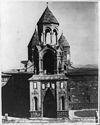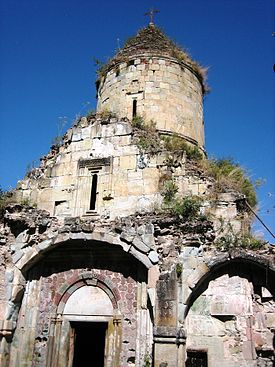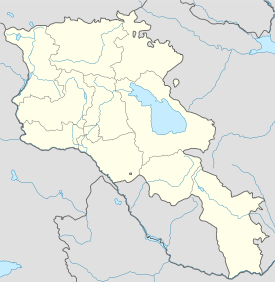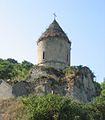- Nor Varagavank
-
Nor Varagavank
Նոր ՎարագավանքNor Varagavank
Basic information Location Near Varagavan, Tavush Province,
 Armenia
ArmeniaGeographic coordinates 40°55′30″N 45°12′06″E / 40.925°N 45.2018°ECoordinates: 40°55′30″N 45°12′06″E / 40.925°N 45.2018°E Affiliation Armenian Apostolic Church Architectural description Architectural style Armenian Completed 12th-14th centuries Nor Varagavank (Armenian: Նոր Վարագավանք) is a 13th century Armenian Apostolic Church monastic ensemble situated 3.5 km southwest of the village Varagavan in the Tavush Province of Armenia. The monastery is situated upon a high hill and is surrounded by forested mountains and picturesque ravines.
Contents
History and Architecture
The monastic complex was established by King David II Kyurikian of northern Armenia in 1193-1198 and expanded by his grandson Vasak II in 1234-1237.[1] The Kyurikians were a junior branch of Armenia’s aristocratic Bagratuni family, whose domain, known as the Kingdom of Tashir-Dzoraget, spanned medieval Armenia’s provinces of Gugark, Artsakh and Utik.[2] The monastery was center of a bishopric, and played an important role in the ecclesiastical life of medieval Armenia. The monastery also served as Kyurikian’s family burial vault and mausoleum.[3]
In early sources the monastic ensemble was called Anapat (hermitage). It was renamed Nor Varagavank (meaning “New Varagavank”) when Vaspurakan's famed Varagavank monastery in Western Armenia near the Lake Van was threatened by the Mongols. Varagavank’s Patriarch Ghukas brought to Anapat holy relics from Vaspurakan in 1213, such as a piece of the True Cross brought to Armenia by the holy virgins Rhipsime and Gayane.[4][5]
Тhe most important structure of the complex is the church of the Holy Virgin. According to the inscriptions on its walls and information provided by the Armenian 13th century historian Kirakos Gandzaketsi, it was built in 1224-1237 by David's grandson Vasak II Kyurikian, and was consecrated in 1240.[6] The church of the Holy Virgin was designed by the architect Gazan who came from the Armenian capital city of Ani. The church is rectangular from the outside (10.25 m x 15.40 m) and cruciform from the inside. The church has two entrances. The western entrance differs by its magnificent reliefs carved on multi-colored stones of the walls.[7]
The Surb Nshan (Holy Sign) chapel is situated in the southeastern part of the monastic complex. It is the most ancient structure of the ensemble. The chapel has two apses. It also had a vaulted gabled roof, which has not been preserved. On both sides of the western entry stand two splendidly ornamented khachkars. The apses are illuminated by two windows on the eastern façade. They are joined by common belt, with relief images of animals and stylized vegetable decor.[8]
Superbly-carved medieval khachkars can be found in various parts of the complex. Especially noteworthy among them is a big khachkar standing near the vestibule of the church of the Holy Virgin. It was created by master Vardan in 1620.
Nor Varagavank is known to have hosted Archbishop Hovhanes Tvetsi, an important Armenian religious and cultural figure of the 13th century who built the main the Holy Virgin church’s narthex between 1237 and 1261.[9] In the beginning of the 19th century, the monastery was headed by Grigor Manucharian, who in 1804-1828, together with a detachment of armed volunteers under his command, took an active part in freeing Eastern Armenia from foreign rule.[10]
Gallery
References
Bibliography
- ^ Kirakos Gandzaketsi. History of Armenia. Yerevan. 1982, p. 117
- ^ Bedrosian, Robert. " Armenia During the Seljuk and Mongol Periods," in Richard G. Hovannisian (ed.): The Armenian People From Ancient to Modern Times, (Volume II: Foreign Dominion to Statehood: The Fifteenth Century to the Twentieth Century). New York: Palgrave Macmillan, 1997, pp. 34-37
- ^ Hasratian, Murad, and Sargsyan, Zaven. Armenia: 1700 Years of Christian Architecture. Yerevan, 2001, p. 170
- ^ Hasratian, Murad, and Sargsyan, Zaven. Armenia: 1700 Years of Christian Architecture. Yerevan, 2001, p. 170
- ^ Holding, Nicholas. Armenia, with Nagorno Karabagh: The Bradt Travel Guide. Bradt Travel Guides, 2004, p. 174
- ^ Kirakos Gandzaketsi. History of Armenia. Yerevan. 1982, p. 117
- ^ Brady Kiesling, Raffi Kojian. Rediscovering Armenia: Guide. 2005
- ^ Holding, Nicholas. Armenia, with Nagorno Karabagh: The Bradt Travel Guide. Bradt Travel Guides, 2004, p. 174
- ^ Kirakos Gandzaketsi. History of Armenia. Yerevan. 1982, p. 117
- ^ Brady Kiesling, Raffi Kojian. Rediscovering Armenia: Guide. 2005
- Kiesling, Brady (2005), Rediscovering Armenia: Guide, Yerevan, Armenia: Matit Graphic Design Studio
- Brady Kiesling, Rediscovering Armenia, p. 114; original archived at Archive.org, and current version online on Armeniapedia.org.
External links
 Historical Armenian monasteries and churches
Historical Armenian monasteries and churches 
Republic of Armenia Aghjots Vank · Akhtala · Arakelots · Arates · Areni · Artavazik · Aruchavank · Askipari · Avan · Ayrk · Bardzrakash · Bgheno-Noravank · Byurakan · Chiki Vank · Daputs · Ddmashen · Deghdznuti · Dvin · Etchmiadzin Cathedral · Gayane · Geghard · Gharghavank · Gladzor · Gndevank · Goshavank · Haghartsin · Haghpat · Harichavank · Havuts Tar · Hayravank · Hnevank · Horomayri · Hovhannavank · Hripsime · Irind · Jukhtak Vank · Kaptavank · Karapet · Karbi · Karmravor · Kasagh · Katoghike · Kecharis · Khor Virap · Khorakert · Khoranashat · Khuchapi · Kirants · Kobayr · Kotavank · Kristapori Vank · Lmbatavank · Makaravank · Makenyats Vank · Makravank · Saint Mariane of Ashtarak · Marmashen · Mashtots Hayrapet · Mastara · Matosavank · Mshkavank · Mughni · Nor Varagavank · Noraduz cemetery · Noravank · Odzun · Oshakan · Pemzashen · Ptghavank · Surb Poghos-Petros · Saghmosavank · Samsoni · Sanahin · Saint Sargis of Ashtarak · Sevanavank · Shativank · Shkhmuradi · Shoghakat · Spitakavor of Ashtarak · Srveghi · Talin · Tanahat · Targmanchats Vank · Tatev · Tatevi Anapat · Teghenyats · Tegher · Tegh · Tsakhats Kar · Tsaghkevank · Tsiranavor of Ashtarak · Tsovinar · Ushi · Vahanavank · Vahramashen · Vanevan · Vorotnavank · Voskevaz · Yeghipatrush · Yeghvard · Yererouk · Zorats · Zoravor · Zvartnots 

Nagorno-Karabakh
Republic (Artsakh)Amaras · Bovurkhanavank · Dadivank · Gandzasar · Gtichavank · Tsitsernavank · Yeghishe Arakyal · Yerits Mankants Azerbaijan Saint Sargis Monastery of Gag · Targmanchats · Nakhichevan: Julfa cemetery List of Armenian churches in Nakhchivan Georgia (country) Holy Mother of God (Mens) · Norashen · Bethlehem St. Astvatsatsin · Armenian Cathedral of Tbilisi · Vera St. Cross · Krtsanis Tsiranavor Surb Astvatsatsin (Geghardavank) · Jigrasheni Avetyats church · Dzorabash St. Gevorg · Zrkinyants St. Gevorg · Kamoyants St. Gevorg · Kuky St. Astvatsatin · Mughni St. Gevorg · Navtlukh St. Gevorg · St. Gevorg · St. Grigor Lusavorich · St. Karapet · St. Minas · Tandoyants St. Astvatsatsin · Hreshtakapetats · Chugureti St. Astvatsatsin Iran Dzor Dzor · Holy Mother of God · Saint Stepanos · Saint Thaddeus New Julfa: Church of Bethlehem · Holy Mother of God · Saint Catherine · Saint Gregory · Saint Minas · Saint Nicholas · Saint Sarkis · Saint Stepanos · Vank Cathedral Israel Cathedral of St. James · Church of the Archangels · St. Toros Church · Chapel of Saint Helena · Saint Nicholas Monastery Turkey Aghtamar · Aprank · Arter · Cathedral of Arapgir · Bagnair Monastery · Banak · Gagikashen · Holy Apostles Church of Kars · Holy Apostles Monastery · Holy Mother of God Cathedral of Ani · Horomos · Karmravank · Khtzkonk · Ktuts · Kümbet Kilise · Lim · Monastery of the All-Saviour (Trebizond) · Mren · Diyarbakir · Narekavank · Saint Bartholomew Monastery · Saint George of Samatya, Istanbul · Saint Hakob of Akori Monastery · Saint Hovannou Monastery · Saint Karapet Monastery · Saint Krikor Monastery · Saint Mary's Monastery of Karmravor · Soradir · St. Marineh Church, Mush · Tekor Basilica · Varagavank · Varzahan Monastery Ukraine Cathedral of the Assumption of the Blessed Virgin Mary · Surb Khach Monastery  Armenia PortalCategories:
Armenia PortalCategories:- Christian monasteries in Armenia
- Visitor attractions in Armenia
- Armenian building and structure stubs
Wikimedia Foundation. 2010.








